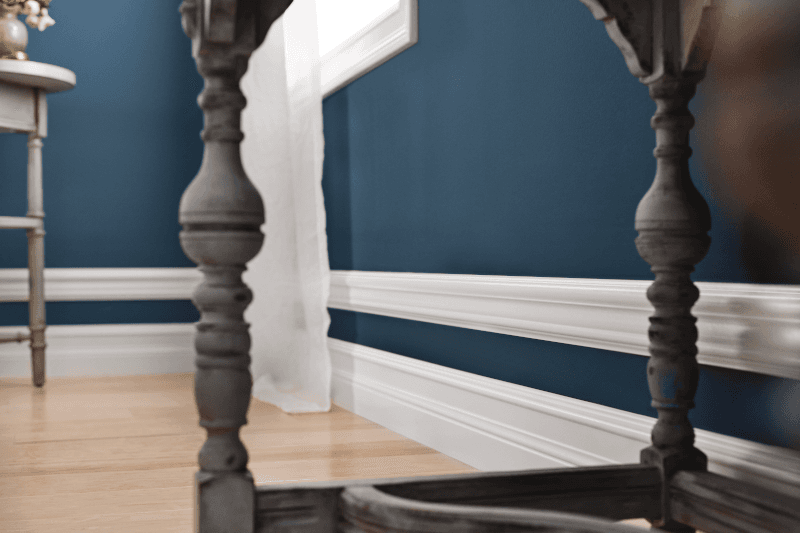Decorative Moulding & Trim: Everything You Should Know
August 8, 2022
By: The Finished Space
Decorative moulding has held a firm place in design for thousands of years. It’s a type of trim used to hide edges and seams. However, unlike other moulding types with a particular purpose, decorative trim can also be used to create custom projects and add a little pizzazz to a space.
In addition, decorative moulding is a term that covers any moulding that serves a decorative purpose in a space, meaning that it can encompass tons of different trim types. So, decorative moulding is both a specific type of trim (usually a thin strip profile) and a broad term that includes all trim types that can be considered decorative.
In this article, we’ll do a deep dive into decorative moulding and trim. First, we’ll cover the different types of decorative moulding and share some ways you can use it in your own home. By the end, you should know everything there is to know about decorative trim and moulding.
12 Types of Decorative Trim
As we discussed above, decorative trim can be a thin strip of moulding used to hide edges and seams. However, it can also refer to any type of moulding whose sole purpose is decorating a space.
Here are twelve examples of that type of decorative trim:
Casings – A type of trim that covers the gap between walls and a window or door frame
Baseboards – A type of decorative moulding that runs along the flooring and the wall
Chair Rail – A functional type of decorative moulding used to protect the wall from furniture and add dimension to a wall
Crown Moulding – The decorative moulding that transitions the ceiling to the wall
Cove Moulding – The concave-shaped moulding found in the corners where the ceilings and walls meet
Picture Rail – A type of decorative moulding that hangs close to the ceiling and allows art to be hung without nails
Wainscotting – A type of moulding placed between the chair rail and baseboards to add character
Cornice Moulding – A horizontal decorative moulding that usually goes on the exterior of a home
Dentil – A type of elaborate moulding that consists of small repeating squares
Egg-and-Dart – Another elaborative decorative moulding that has repeated dart and egg shapes
Batten Moulding – A finishing touch that’s also called board-and-batten that’s used to hide the joint between paneling
Pearl and Bead Moulding – These two types of decorative moulding feature small rows of symmetrical spheres
These twelve types of decorative moulding are just some of the most popular types.
However, any moulding that adds a decorative element to a room can be considered decorative moulding.
How to Use Decorative Moulding Trim to Jazz Up Your Home
Now that you know some types of decorative moulding trim, let’s look at some decorative moulding in action so you can see what a huge impact it makes.
Using Decorative Moulding and Paneling to Create Visual Impact
This chic sitting room masterfully uses decorative trim to create panels on the wall. The panels are further accentuated with complementary wallpaper inside the panels. It creates a picture frame aesthetic without picture frames. In addition, the chair rail moulding in the same subtle green further elevates this exquisite design.
A Thick Picture Moulding In a Contrasting Color
In this corner, you can see several uses of decorative moulding. First, there’s the crown moulding on top and the picture moulding a few inches beneath it. Then, there’s the door casing and architrave around the door. All these bright white decorative moulding pieces contrast beautifully with the bold blue wall color to create a dramatic visual effect.
Mix-and-Match Decorative Moulding Trim Types
This elegant sitting room effortlessly combines multiple decorative trims and textures to create a sleek and visually stunning sitting room. From the black door casing and the paneling behind the floating shelf to the matching casing around the windows and inset ceiling, this room uses decorative moulding tastefully to create a complex, yet controlled, final look.
Paneling and Baseboards to Complement Bold Choices
This bold bathroom doesn’t shy away from daring color and design choices. From the checkered floor to the hot pink door, there’s a lot going on. However, what makes this bathroom work is the attention to detail, including the decorative baseboards and subtle ceiling paneling that really elevate this room to new heights without pulling away from the focal points.
Get Started with Decorative Moulding
If you’re ready to start using decorative moulding in your home’s design- you’ve come to the right place. At Metrie, we bring together the world’s top designers to create beautiful decorative moulding and trim to complete any design aesthetic.
If you aren’t sure what type of decorative moulding is right for your aesthetic, give Option {M} a try. It’s our design tool that helps match finishing touches with popular design trends, so you can get some clarity on what works best. If you’d like some more inspiration, check out our design gallery to see more examples of how other people have used decorative moulding in their homes to elevate their interior design.

